When was it built: From 1896 to 1906
Who built it: British
Time taken: 10 years
Where is it located: Port Blair, the capital city of the Andaman and Nicobar Islands, India
Why was it built: As Solitary Confinement
Architectural Style: Cellular, Pronged
Visit Timing: 9.00 am to 12.30 pm, 1.30 pm to 4.45 pm
How to Reach: Port Blair is well-connected with many cities of mainland India by sea and air.
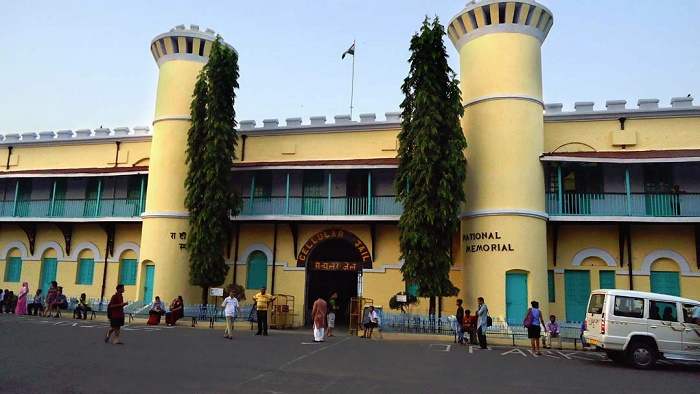
Cellular Jail in Andaman and Nicobar Islands, India, stands as a dark reminiscence of the British rule in the Indian subcontinent. This most dreaded and gruelling colonial prison situated in the remote archipelago was used by the British particularly to exile Indian political prisoners. Isolated from the mainland, this jail, also referred as Kala Pani (where Kala means death or time and Pani means water in Sanskrit) witnessed the most atrocious punishments imposed on prisoners. India’s struggle for independence saw imminent freedom fighters like Batukeshwar Dutt and Veer Savarkar being incarcerated in this jail. The jail is now open to public viewing as a National Memorial, and its museum gives one a glimpse of years of India’s struggle for freedom.
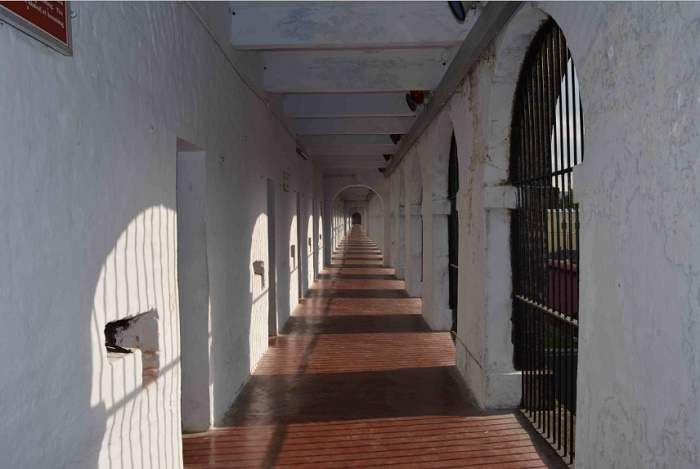
Image Credit: https://rumadak.files.wordpress.com/2015/01/comdsc_0035.jpg
Foundation & History of the Jail
Although the Andaman Islands were used by the British as a prison soon after the Indian Rebellion of 1857 (the Sepoy Mutiny), the foundation of this jail was laid in 1896. The result of what was considered India's First War of Independence however went in favour of the British who suppressed the revolt executing many rebels and transferring the rest to Andaman for lifetime exile. The rebels in hundreds were sent to the island where they remained under the custody of jailer David Barry and military doctor Major James Pattison Walker. 238 prisoners who tried to escape the jail in March 1868 were caught in April of whom 87 were hanged. More and more patriots who raised voice against the colonial rule were convicted and deported here from British-controlled India and Burma.
The prisoners dreaded the waters of Andamans and being isolated from the mainland there were no way out for them to escape. The island became an apt place for the British to punish the freedom fighters. The prisoners were chained and made to work in constructing buildings, prisons and harbour facilities in pursuit of colonising Andaman for the British. With the upsurge of Indian independence movement in the late 19th century, several prisoners were sent to Andaman that necessitated for a higher security prison. Sir Charles James Lyall, home secretary in the governance of the British Raj and A. S. Lethbridge, a surgeon in the British administration suggested introduction of a “penal stage” in the transportation sentence given to a prisoner so that the prisoner face harsh treatment for a certain period after deportation to the Andamans. This led to construction of the Cellular Jail, work of which commenced in 1896 and finished in 1906.
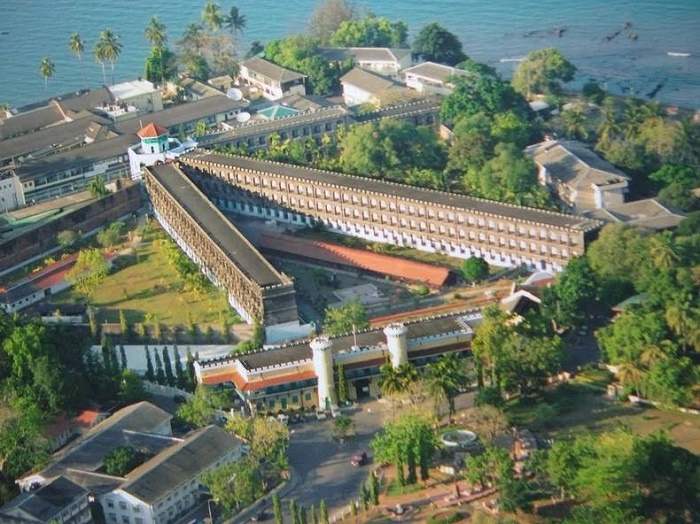
In 1942 the Japanese overpowered the British in the Andaman Islands driving them out of the islands. Netaji Subhas Chandra Bose visited Andaman during this time. Following the end of the ‘Second World War’, in 1945 the British regained control of the islands.
Design of the Cellular Jail
The building of the Cellular Jail originally had seven straight wings each connected to a tower in the middle giving the whole construction a look of something like a bicycle wheel with each wing attached with the centre tower like a spoke of the wheel. This design was based on English philosopher and social theorist Jeremy Bentham’s concept of the Panopticon. Puce coloured bricks were brought from Burma to construct the building. The tower in the centre that formed the point of intersection of all the seven wings served as a watch point for the guards of the jail to keep vigil on prisoners. It had a large bell for raising alarm. The wings, each of which had three storeys, were constructed in such manner that the front of one wing faces the back of another so that one inmate in a wing cannot see or communicate with another inmate in any of the adjacent wings. Even the cells in a wing were in a row so that inmates in the same wing also cannot communicate or see each other. Each cell housed only one prisoner ensuring minimal chance of communication among inmates thus isolating them from each other. This feature of solitary confinement in individual cells earned the jail its name, “Cellular”. There were a total of 693 cells, each measuring 4.5 m by 2.7 m with a ventilator located at a height of 3 m. There were no dormitories in the jail.

Life in the Jail
Notable freedom fighters confined in the jail included Batukeshwar Dutt, Diwan Singh Kalepani, Fazl-e-Haq Khairabadi, and the Savarkar brothers - Babarao Savarkar and Vinayak Damodar Savarkar among others. Being in solitary confinement the Savarkar brothers were unaware of each other’s presence in the same jail for two years. Many freedom fighters in the jail went through inhuman and unimaginable tortures, the very thought of which brings chills down the spines. The jail drew attention when its inmates observed hunger strikes in the early 1930s. Bhagat Singh’s associate in the freedom movement, Mahavir Singh went on a hunger strike in protest of such cruel treatment but died when authorities tried to feed him milk forcibly which went to his lungs. His body was thrown into the sea. In 1937-38 following intervention by Mahatma Gandhi and Rabindranath Tagore the government decided on repatriating the freedom fighters.
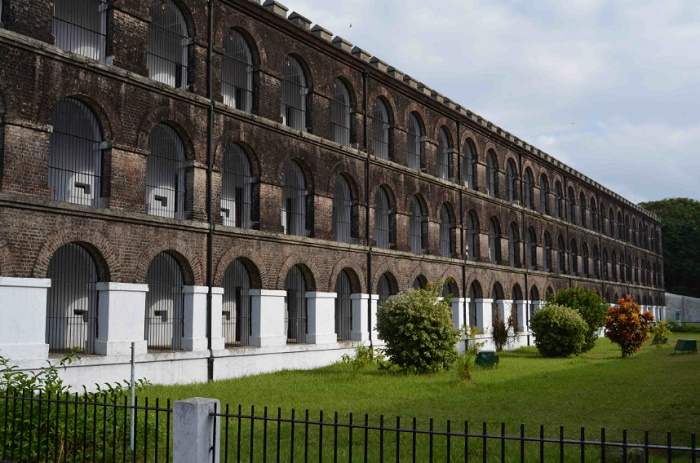
Image Credit: rumadak.files.wordpress.com/2015/01/comdsc_0020.jpg
Visiting the Cellular Jail
Over the years, the building was damaged and only three wings and the tower remains. In 1969 it was converted into a National Memorial. Tourists from India and around the world visit the island which is predominantly famous for the Cellular Jail apart from its scenic beauty. The National Memorial houses several galleries including Freedom Fighters Photo and Exhibition Gallery in the ground floor and an Art gallery and Netaji Gallery on the first floor among others.
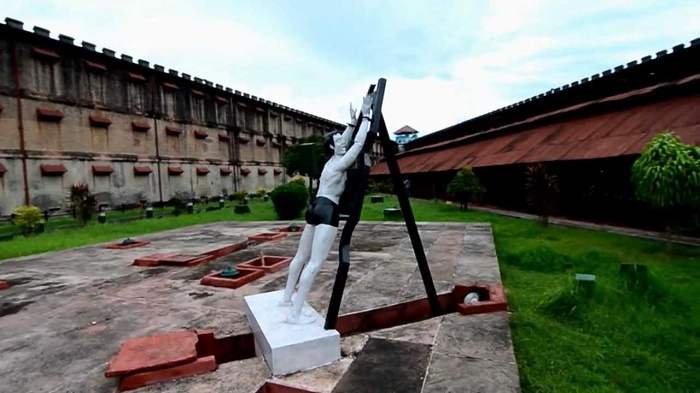
Image Credit: youtube.com
Visit Timing & Entrance Fee
It remains open on all days excepting national holidays. Entry fee per person is Rs. 30/-. Other charges include Rs. 200/- for still camera, Rs. 1000/- for video camera and Rs. 10,000/- for film shooting per day with prior permission.
Light & Sound Show
It regularly holds Light & Sound (Son-et-Lumiere) shows on India’s freedom struggle in Hindi and English excepting on every Monday, Wednesday and Friday. The price of ticket for the light and sound show is Rs. 50/- per adult.



